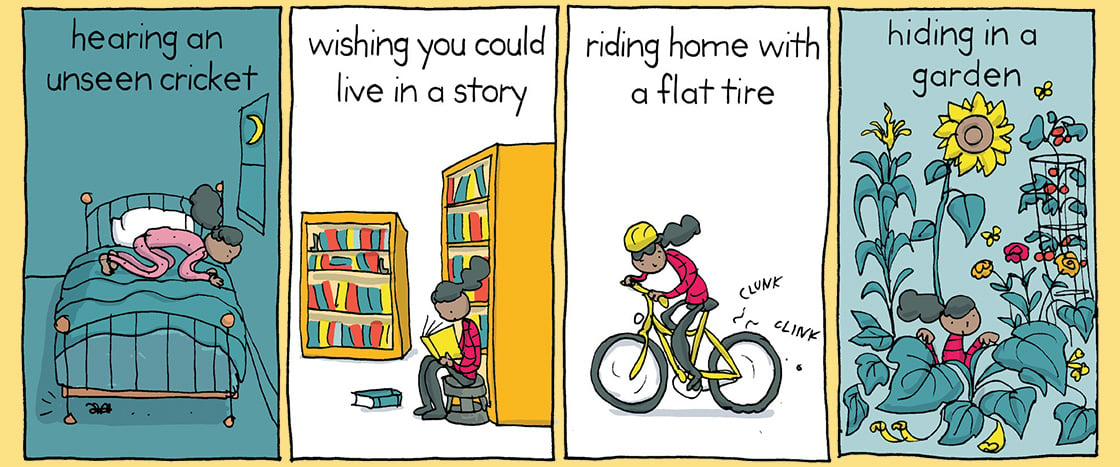hearing an unseen cricket
wishing you could live in a story
riding home with a flat tire
hiding in a garden

A graphic poem reminds us to pay attention and give voice to life’s smaller moments
Learning Objective: Students will identify mood in a 12-panel graphic poem about everyday moments in life.
Art by Grant Snider
hearing an unseen cricket
wishing you could live in a story
riding home with a flat tire
hiding in a garden
Art by Grant Snider
watching light dance underwater
drying off with a wet towel
walking into a spiderweb
chewing an eraser
Art by Grant Snider
feeling full from dinner but hungry for dessert
spending too long in the bathtub
feeling like your life is changing . . .
faster than you can keep up
FROM THE POETRY COMICS SERIES BY GRANT SNIDER © 2024 GRANT SNIDER. USED WITH PERMISSION FROM CHRONICLE BOOKS, LLC. VISIT WWW.CHRONICLEBOOKS.COM
This poem was originally published in the May/June 2025 issue
Click here for great ideas for using Storyworks as a whole class, in small groups, or independently!
1. Preparing to Read
Direct students to read the title of the poem and look at the illustrations. Invite them to make a prediction about what the poem will be about.
Point out that this is a graphic poem: The poet combines words and art to create the meaning of the poem.
Ask a volunteer to read aloud the Up Close box at the top of the page.
2. Reading the Poem
Read the poem aloud, or play our Audio Read-Aloud.
Go back to the question in the Up Close box and have students discuss their responses with a partner.
Discuss the poem as a class, using the questions that follow as prompts.
3. Discussing the Poem
1. Study the words and images in the first 10 panels. What do these panels have in common? How are the final 2 panels different from the first 10? (text structure) Each of the first 10 panels includes a phrase and a drawing that illustrates that phrase. The phrases begin with an -ing verb and describe something people might encounter in everyday life. The same girl appears in each panel, doing what is described in the text. The first 10 panels stand on their own, but the final 2 panels are connected to each other. The illustration and words that start in the 11th panel are continued in the 12th. We see the girl putting on new running shoes in one illustration and then running quickly while wearing them in the following panel. Also, the 12th panel is the only one that doesn’t begin with an -ing verb. While the other panels focus on a moment in time, the final 2 panels remind us that life is always changing and moving forward.
2. What are some examples of how Grant Snider uses language and art to appeal to our various senses? (sensory details) Possible answers include: Snider appeals to our sense of hearing in the first panel by using the word hearing and by showing sound lines coming from the cricket. In the third panel, the words CLUNK and CLINK tell us the flat tire is making noise as the girl rides her bike home. Our sense of touch is activated by the words and illustrations of several panels. For example, we can imagine the sticky feeling of unintentionally walking into a spider web or the unpleasant and frustrating sensation of trying to dry off using a towel that’s soaking wet. The words “chewing on an eraser” help us think about both the taste and feeling of eraser bits in our mouth. All the artwork appeals to our sense of vision, along with language like “watching light dance underwater.”
3. What do you think Snider wants us to think and feel about day-to-day experiences, based on the poem? (author’s purpose) Snider probably wants us to pause and reflect on small moments in life so we can fully appreciate them. Because life can sometimes feel like it’s going by quickly, it’s important to slow down and notice what we’re experiencing and feeling.
4. Think about the title of the poem. What do you think it suggests about what words can and can’t do? Do you think all feelings can be named? (main idea) The title suggests that, while there are words to name many feelings, there are some feelings that are hard to sum up in words. The poem gives examples, in words and pictures, of experiences that bring up feelings that many of us share, but the poet evokes the feeling by describing the experience instead of naming the feeling. Answers will vary for the second question.
5. Choose one panel from the poem and describe the feeling, or feelings, that the words and illustration stir within you. (mood, making connections) Answers will vary.
4. Skill Building
Distribute or digitally assign the Poetry Kit, which will take students on a deep dive into the poem and offer opportunities for students to connect the poem with other stories in the issue.
Connect this poem to “How Do You Say . . . ?,” our infographic about extraordinary words from other languages that have no equivalent in English. Read another graphic poem that focuses on feelings, “My Inner Weather Report.”
Enjoy more delightful poems by Grant Snider at his blog Incidental Comics.
RocketKids’ engaging 4-minute video has some great tips for knowing and expressing your emotions. (Note: Video begins after a short advertisement.)
Introduce your students to an emotion wheel as a great aid for identifying and expressing feelings. Go to the Brainframe webpage that provides tips for using emotion wheels and links to templates for creating your own.